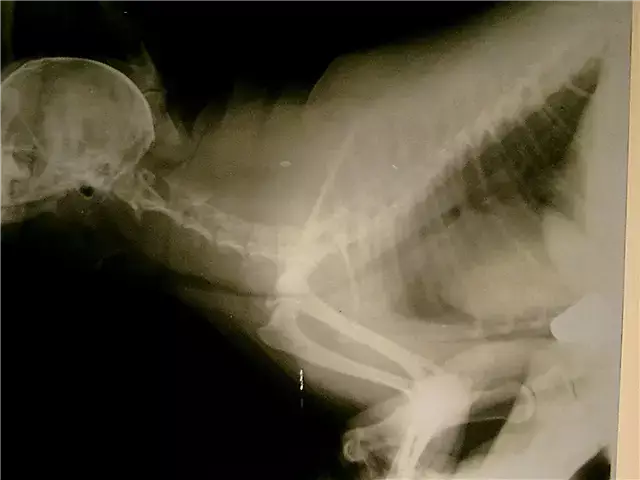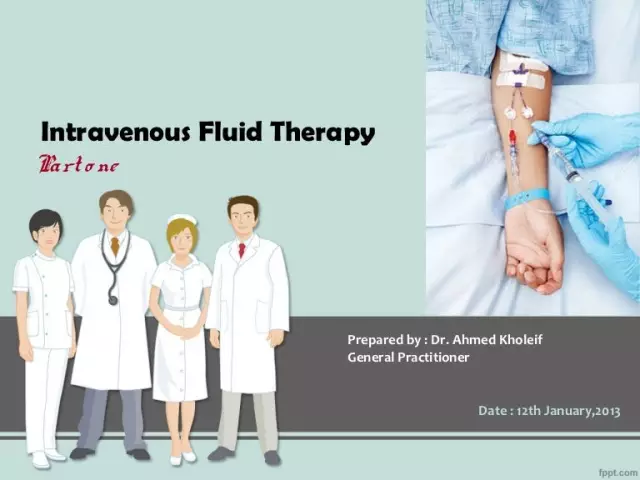- Author Rachel Wainwright [email protected].
- Public 2023-12-15 07:39.
- Last modified 2025-11-02 20:14.
Venofundin
Instructions for use:
- 1. Release form and composition
- 2. Indications for use
- 3. Contraindications
- 4. Method of application and dosage
- 5. Side effects
- 6. Special instructions
- 7. Drug interactions
- 8. Analogs
- 9. Terms and conditions of storage
- 10. Terms of dispensing from pharmacies

Venofundin is a plasma-substituting agent with high tolerance and a reduced risk of anaphylaxis.
Release form and composition
Venofundin is produced in the form of a solution for infusion 6%: slightly opalescent colorless or pale yellow liquid (500 ml in polyethylene bottles, 10 bottles in a cardboard box; 250, 500 or 1000 ml each in plastic containers enclosed in transparent plastic bags, in a cardboard box 20 containers of 250 or 500 ml or 10 containers of 1000 ml).
1 liter of solution contains:
- active substance: HES (hydroxyethyl starch with an average molecular weight of 130,000 Daltons and a degree of molar substitution of 0.42) - 60 g;
- auxiliary components: sodium chloride, sodium hydroxide, water for injection.
Main characteristics:
- electrolyte concentration: chlorides and sodium - 154 mmol / l;
- physicochemical properties: theoretical osmolarity - 309 mOsm / l; pH - 4.0-6.5.
Indications for use
Venofundin is recommended for the prevention and treatment of hypovolemia in cases of acute blood loss (burns, sepsis, intraoperative bleeding), when only crystalloid blood substitutes are not effective enough.
A solution of hydroxyethyl starch is also used when carrying out acute normovolemic or therapeutic hemodilution, and to fill the extracorporeal circulation apparatus.
Contraindications
Absolute:
- hyperhydration due to impaired water-salt metabolism (including pulmonary edema);
- CHF (chronic heart failure);
- acute renal failure in the oliguric / anuric stage;
- severe hypernatremia / hyperchloremia;
- decompensated liver failure;
- intracranial hemorrhage;
- revealed increased sensitivity of the body to HES, causing an allergic reaction.
Relative (the solution is used with caution):
- liver failure;
- blood clotting disorders (especially in the presence of identified / suspected von Willebrand disease, hemophilia);
- children's age (due to insufficient knowledge of the safety and efficacy of Venofundin administration in this age group of patients).
During pregnancy, especially in the first trimester, HES is prescribed only if the potential benefit of the drug to the mother outweighs the possible risks to the fetus.
There is not enough clinical data on the use of the solution during lactation, whether HES is excreted in breast milk is unknown, therefore, when prescribing Venofundin, lactating women need to provide for the possibility of interrupting breastfeeding.
Method of administration and dosage
The solution is intended for intravenous administration.
The daily dose and the rate of administration of the solution are calculated depending on the amount of blood loss and hemodynamic parameters.
The maximum daily dose of the solution is determined at the rate of ≤ 50 ml / kg of body weight (in terms of hydroxyethyl starch - 3 g / kg of body weight), which corresponds to a dose of 3500 ml per day for a patient with a weight of ~ 70 kg.
The maximum rate of administration is determined depending on the clinical situation; for the acute stage of shock, it is recommended to inject up to 20 ml / kg of body weight per hour (in terms of hydroxyethyl starch - 1.2 g / kg), which corresponds to a rate of 0.33 ml / kg of body weight per minute.
Possibly accelerated (under pressure) introduction of the solution in a critical situation in a volume of 500 ml. If the drug is used in plastic containers, in order to avoid the risk of embolism from the containers and the injection system, it is necessary to remove all air in advance.
The duration of treatment depends on the hemodynamic effect, the level of hemodilution, and the severity and duration of hypovolemia.
Side effects
Most often, during therapy with Venofundin, side effects arise that are directly related to the action of the hydroxyethyl starch solution and its dose. With hemodilution, if therapy with a HES solution is carried out without the simultaneous administration of blood components, a decrease in coagulation factors is likely.
Most likely side effects:
- anaphylactic reactions: rarely - immediate-type allergic reactions of varying severity (they are not dose-dependent, require immediate discontinuation of the infusion and emergency therapy; constant monitoring of medical personnel during HES therapy is necessary). The effectiveness of the use of corticosteroids for the prevention of anaphylaxis has not been proven; with repeated infusions of HES solutions for several days, itching may appear;
- circulatory and lymphatic systems: very often - a decrease in the plasma concentration of proteins and hematocrit due to hemodilution; often (when using high doses) - a decrease in the concentration of coagulation factors and, as a consequence, a decrease in blood clotting, an increase in bleeding time and the APTT index (activated partial thromboplastin time), a decrease in the activity of FVIII / vWF (von Willebrand factor VIII);
- biochemical indicators: an increase in plasma concentration of α-amylase associated with the formation of a complex of α-amylase + starch, which is slowly excreted by the renal and extrarenal pathways, mistaken for a biochemical sign of pancreatitis.
The main consequence of an acute overdose can be hypervolemic overload, a condition requiring the immediate cessation of the administration of Venofundin and the use of diuretics, if necessary.
special instructions
In case of concomitant cardiac pathologies, the dose of hydroxyethyl starch should be carefully selected in order to avoid volume overload arising from an overdose.
For elderly patients, constant observation and individual selection of the dose of the drug are required.
Ensure adequate rehydration, fluid balance, renal function and serum electrolytes should be monitored. Replenish electrolytes and fluids, if necessary, taking into account the individual needs of the patient.
It is recommended to monitor renal function within 3 months from the date of Venofundin infusion.
The function of the blood coagulation system should be monitored in patients in the event of open heart surgery using a heart-lung machine, since there is evidence of increased bleeding when such patients use other HES drugs.
Treatment with Venofundin does not affect the determination of the blood group.
The first 10-20 ml is injected slowly under the continuous supervision of medical personnel in order to identify the threat of anaphylaxis as early as possible.
Do not use a solution containing visible mechanical inclusions, opaque, from previously opened or damaged bottles / containers.
Drug interactions
Do not mix Venofundin with other drugs to avoid incompatibility.
Analogs
Analogues of Venofundin are: Volekam HEC-200, Volekam, Volemkor, Voluven, Geta-Sorb, Hydroxyethyl starch, Hemohes, HydroxyethylStarch 200, Infukol HES, Hydroxyethyl starch-Eskom, ReoHES 130, ReoHES 200, Stabizol ReoHES 200, Stabizol ReoHES HES 6%, HAES-steril.
Terms and conditions of storage
Store at 2-25 ° C. Keep out of the reach of children. Do not freeze!
Shelf life: in plastic bottles - 3 years, in plastic containers - 2 years.
Terms of dispensing from pharmacies
Dispensed by prescription.
Information about the drug is generalized, provided for informational purposes only and does not replace the official instructions. Self-medication is hazardous to health!






